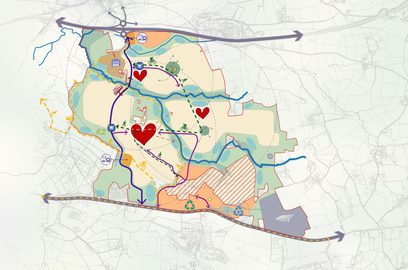Class E and Changes of Use

Tibbalds
In light of the current consultation to allow change of use between Class E and residential uses, Tibbalds’ Associate, Richard Crutchley, looks at the impact such a move could have in his neighbourhood, involving a recently vacated unit in a terrace of shops.
“When someone produces a simple solution to a complex problem, that’s the wrong solution”Gil Kerlikowske
Former commissioner of the US Customs and Border Protection agency
So says Gil Kerlikowske, former commissioner of the US Customs and Border Protection agency about Donald Trump’s wall. Such words are often applicable to other complex problems.
My exercise routine during the pandemic has frequently revolved around the local centres close to my home. I’m lucky to have a parade of shops – including a post office, newsagent, supermarket and my favourite model shop – available on the same block as my house, or by crossing one road. Seven minutes up the hill, there’s a second centre focused around the railway station and green, a very pleasant late Victorian environment with a cluster of shops and take-aways which has proved a welcome honey pot for the community limited in the things they can do and the places they can go (albeit a head-scratching problem for the Council and police trying to maintain social distancing). If exercise constitutes walking up the hill, getting a coffee and walking back, then this is what makes for my daily routine.
Local centres have been essential to many through lockdown
Here, the local shops – and they are predominantly independents – have seemed to find a way, opening when allowed and offering ‘click and collect’ when not open and, it seems to me, the local community value them. Those offering services and every day goods seem to have done very well, judging by my observations of footfall and conversations with proprietors. It’s an interesting counterpoint to the national rhetoric that bricks and mortar shopping is on its knees and trade is going online. To my mind, that’s a factor of where you look. Guess what – it’s a complex problem.
As a town planner with over twenty five years experience, one of the most troubling trends in the profession has been the gradual erosion of tools available to the planner in an effort to simplify the planning process. The incremental increase of permitted development (PD) has been, perhaps, the most obvious example. Working in west London seven years ago, I recall real trouble with the introduction of office to residential PD and, since then, PD rights have grown wider.
The Government’s focus is on housing, and ensuring that there is availability of good housing for all members of society. The widening of PD seems to have the provision of more housing from a diverse range of sources at its core. It is not clear to me how this dovetails with other important considerations, such as the quest for ‘beauty’ and the maintenance of thriving, successful and sustainable communities. It is trying to be responsive to the changing picture on high streets, perhaps erring on the side that generally they are struggling.
And so, with housing numbers weighing heavily in its mind, the Use Classes Order has been radically altered, grouping shops, businesses and community services together in a new Class E, and allowing a myriad of changes to different uses. The latest consultation, with a deadline of January 28 this year, proposes a PD right to change Class E to residential use.
Up around the green, the one bank has just closed, and the unit is now vacant. It has a large sign in the window saying that this Class E use is ‘to let’. It struck me that this could, in future, be open to a change of use to residential under the new regime and led me to think about the potential impact of this in real terms to a specific local centre (I should note that this particular unit is within a Conservation Area and would be subject to a more scrutiny).
The now vacant former bank sits in a prominent position
Whilst a conversion to residential use would inevitably provide some housing, there would be a question around it meeting local needs and over its quality. It would provide more people in the area to use the remaining shops and services, although the number of businesses has been reduced by one. Because of the emphasis on providing homes, the PD right is less concerned about the change of use from housing to shops, and so it is likely that the converted shop unit is lost for good to housing; the flexibility implied by the loosening of restrictions only works one way.
In this case, the shop unit is one of a short parade of ground floor units, so the continuity of active ground floor uses, useful in animating the centre, is lost. In this case, it may be that some of the architectural harmony of the terrace is also lost through the removal of a shop front, depending on the frontage to the residential use that replaces it. There are many examples of conversions of shopfronts within local centres that are insensitive. Also in this case, the one (free) cash machine in the centre is also lost, potentially making this centre marginally less attractive; one service has disappeared.
The unit is one of a row of shops, which provide ground floor activity. Conversion to residential would compromise this.
What may be the most damaging element is the gradual piecemeal erosion of shops from local centres as landlords and landowners look for short term solutions to the uncertainty caused by the pandemic to shops and businesses. They may see residential use as a more certain, consistent use than a retail use. Repeated many times, randomly through many town and local centres, it may have the effect of undermining the attractiveness of clustered services and, whilst putting more people in centres to live, deprive them of the services they might have needed by allowing them to change into dwellings as well.
Town centres and high streets – in all their various scales and guises – need careful thought and planning to ensure that the most appropriate changes are made in response to economic fluctuations. Securing vibrant and sustainable centres means looking at them as a whole in their context and support the concentration of services to the benefit of the catchment using it over the longer term. An approach that encourages quick change when opportunities arise to meet a current, or short term, objective – particularly one that is difficult to reverse – could spell trouble in the years ahead when times are better. One can draw on examples such as Lordship Lane in Dulwich, where a more patient, long term view is now paying dividends. What the pandemic has demonstrated is the human need for interaction, and the importance of having this locally. Clusters of shops and services close to people’s homes, providing a service that is instant rather than reliant on delivery, is essential to our welfare and well-being. Town and local centres are complex, and the application of generic – simple – solutions to resolve issues is going to have a varied impact. When it comes to town centres, a locally considered bespoke response may be favourable to a heavy handed, nationally applied rule that may cause more harm than good.
Topics:
Related Updates

Marlcombe, East Devon selected as one of the New Towns

Tibbalds

Lizzie Le Mare attending LREF 2025

Tibbalds
Newham Council’s 50% affordable Carpenters Estate regeneration gets underway

Tibbalds
Stay In Touch
Sign up to our Newsletter
Subscribe to our newsletter to receive updates about making people friendly places.